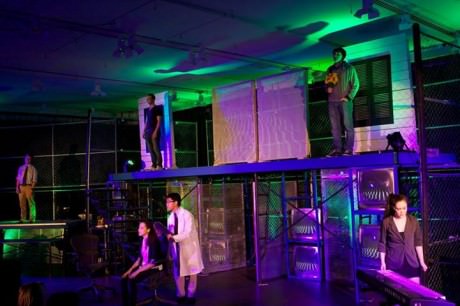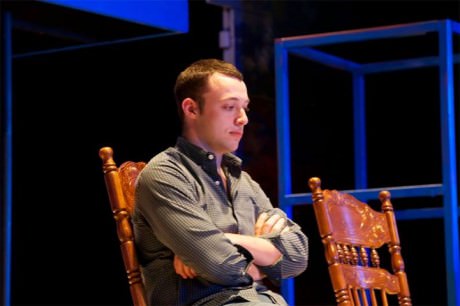When approaching an issue as sensitive and pervasive as mental illness, even the most seasoned performers can underplay the massive implications of a disorder or dramatize it to the point where it reads as an offensive caricature. However, the players of Act Two @ Levine superseded their reputation as a “Pre-Professional Program” in their moving and technically complex production of Next to Normal. In what may prove to be one of the most definitive pieces of drama produced in the previous decade, Next to Normal gives voice to suburban families faced with the stigma that their lives are devoid of “real problems,” when in reality hardships ranging from psychiatric and psychological tribulations to substance and self afflicted abuse lurk behind every corner. The literary merit of this script (which earned the show a Pulitzer Prize) was far from lost on these high school aged performers. Each issue was handled with dignity and passion, leading to some hard hitting moments that may be closer to home than you might expect.
Kevin Kuchar’s direction capitalized on the book’s propensity for artistic intricacy. His staging always felt completely genuine while never becoming restricted by exact realism. Every moment had beautiful scene composition; a visually captivating stage picture would begin to develop as soon as the last one faded away. Kuchar’s conceptual work was also evident in the overall feel of the show, with all of the technical areas working in tandem with the actors and each other. Even more important than all of these contributions to his show, Kuchar’s commitment to imbuing proper and visceral acting training to those in his program made this show unforgettable, as the characters and their emotional turmoil were appropriately put center stage.

Despite this, there were some issues in the production. Due to the production’s limited time frame and availability of their acting space (a black box at Arena Stage), the troupe only had one day to implement their technical elements into the show. Because of this, the stage crew was persistently obtrusive, often seeming unaware that they should not be attracting as much attention as they did. Mid-song scene changes andcrew members visibly watching the show constantly detracted from the drama occurring a few feet away from them. Similarly, actors would make minor costume changes against the back curtain, an area which was unfortunately fully lit and visible. Finally, Kuchar’s artistic vision occasionally split the focus as he would place extraneous characters on stage for aesthetic value.
With those negligible weak spots aside, the brilliance of this production shines through. The highlight of the performance for me was Kayla Dixon’s explosive interpretation of the mentally unstable Diana Goodman. Dixon’s portrayal of bipolar disorder was remarkable. I was astounded by how she perfectly walked up to the line of overdoing her most neurotic moments while creating a wholly realistic character that is absolutely believable at every moment. The true uniqueness of her performance can be best captured in her performance of “I Miss the Mountains,” in which she takes a song that could be dismissed as another Diana-acting-crazy-scene into a vocal tour de force in which she clearly communicates the rational reasoning for her erratic behavior, causing her downfall to be all the more comprehensible and relatable.
Few performers are able to capture all sides of Diana’s complex character; however, Dixon went above and beyond, adding an immense amount of personal awareness to one of the most difficult roles in modern musical theater. Additionally, Dixon had spectacular vocal talent. She masterfully sang this difficult role with brutal emotional clout along with a set of soulful lungs that effortlessly took her melodies to the roof. Her sacrifice of exact form for eruptions of rash screams and shouts were well placed and properly motivated, backed up by a dynamic interpretation of her songs. Dixon’s Diana was near perfect in all regards.
Playing her devoted husband Dan, Eitan Mazia gave a compelling performance beyond his years. With a spot-on tonality, Mazia held up many complex harmonies and numerous solos. His heart-rending reprise of “I Am the One” seemed to overtake him with emotion and drained the power typically found in his voice, leaving him as a husk of an abandoned man. Noah Kieserman also excelled in both acting and singing as Henry, encapsulating the stoner stereotype while creating an empathetic and lovable character.
With an ethereal stage presence, Sean Watkinson’s Gabe was unnervingly likable and hauntingly childlike. Serving as the manifestation of Diana’s insanity, Watkinson was a walking contradiction, whose mix of power and grace left the captivating question of whether he was an angel or a demon. Beyond that, his falsetto riffs and rock-edged vocals made him a musical highlight.
Joey Ledonio maintained a professional distance as Doctor Madden, keeping his emotions from becoming entangled with his patients. His apparent lack of empathy contrasted with his medical passion, painting the portrait of a true to life psychiatrist. Francesca Rowe proved her value with one of the strongest set of pop vocals among the cast, although the acting of her descent into medication abuse was underwhelming. Her interpretation of Natalie came off more as a somewhat irresponsible teenage girl instead of the impending disaster, fueled by drugs and a fear of inherited insanity, that her role asks for. Despite this, sparks flew in her scenes with Kieserman, whose budding romance is near impossible not to root for.

The technical designs seemed reminiscent of the original Broadway lights and sets while carving out innovations unique to this production. The sets incorporated towering walls of chain link fence lined with a grid of light bulbs across it. The metallic elements that made up almost the entire set worked dazzlingly with the lights, reflecting the cool purples and blues that illuminated the actors. While lighting cues did occasionally seem a tad choppy, the muted neon color palette and multitude of instruments (considering their intimate space) produced quite the spectacle. Kuchar’s implementation of projections and television set-stacks made huge impacts in every scene they were utilized in, displaying awe-inspiring starry nights or creating an air of discomfort as they lit up with stacks of oddly colored pills.
With an emotionally charged production that maintains the artistic integrity of the original script, Act Two @ Levine’s production of Next to Normal is nothing less than electrifying.
Running Time: Three hours, with one fifteen minute intermission.
Next To Normal plays today at 2 PM at Act Two @ Levine at Arena Stage’s Ammerman Theater – 1101 6th Street SW, in Washington DC. Purchase tickets at the door.





I would like to give Francesca Rowe recognition for her performance as Natalie Goodman, the daughter of the troubled Diana. Francesca’s flawless vocals provided brief moments of relief from the intense moments found in the rest of the production. Francesca’s rendition of “Superboy and the Invisible Girl” showed the vulnerable side to her character, who feels she is constantly overshadowed by her mother’s illness. Cameron Mitchell also gave an upstanding performance as Doctor Fine, who explains Diana’s extensive treatments.
I am so proud of the students in this Pre-Professional Program. This performances in this show were so moving. I am grateful that the students are getting such positive recognition. I would also like to mention the wonderful performance by Francesca Rowe who brought me to tears and made me laugh as Natalie as well as Cameron Mitchell’s performance as Dr. Fine. Congratulations to all!
Here is Jennifer Perry’s wonderful article, review, and interview with cast members and the director on BroadwayWorld. Thanks Jennifer for covering these talented young performers.
http://dc.broadwayworld.com/article/BWW-FeaturesReviews-Extraordinary-Young-Talent-on-Display-in-Act-2-Levine-NEXT-TO-NORMAL-20130520